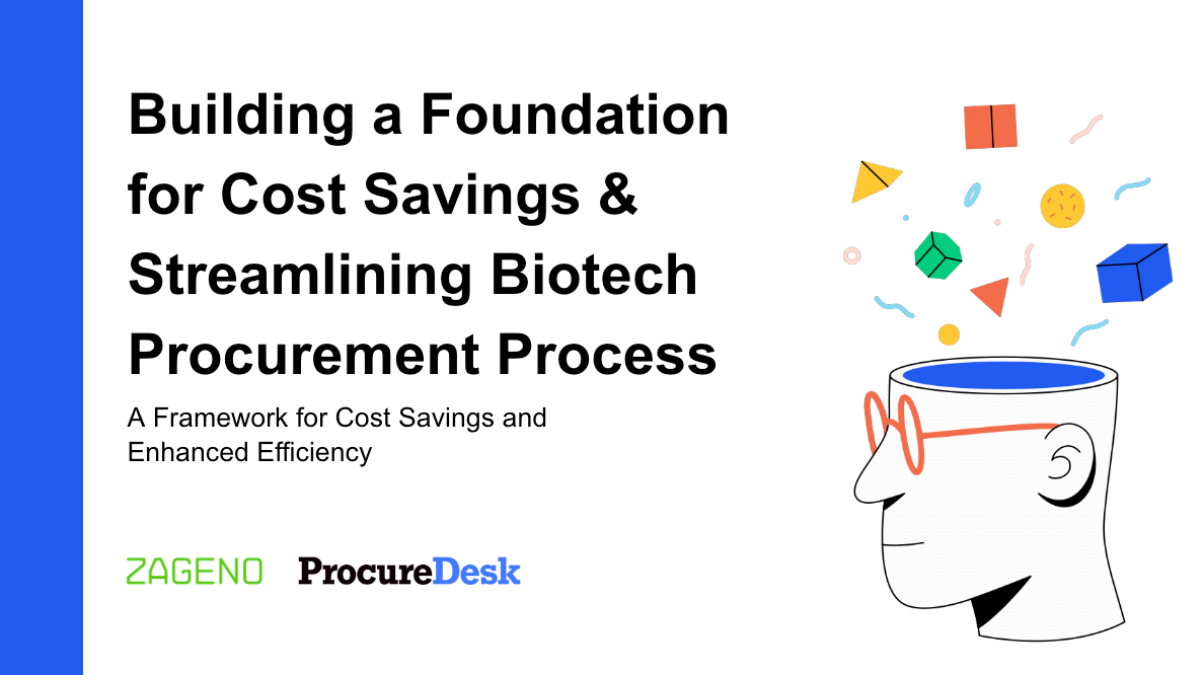Innovation isn’t the only key to success in the biotech world—efficiency and cost control are just as important. As labs scale, outdated procurement processes can drain resources and hinder growth. In a recent webinar, Nick Proch of ZAGENO and Sachin Sharma of ProcureDesk discussed strategies to address these challenges, including the Procurement Growth Model. This model provides a roadmap for assessing and improving procurement practices across four maturity levels. By adopting this approach and leveraging tools like the ZAGENO lab supply marketplace, scaling biotech companies can align procurement to support their growth.
Understanding procurement challenges in biotech
Procurement in growing biotech companies often encounters significant challenges that can hinder growth and operational efficiency. A recent study by ProcureDesk explored procurement and accounts payable management at over 50 biotech firms to shed light on these issues. The study involved a diverse group of respondents, including CFOs, VPs of Finance, Controllers, CEOs, and CSOs, representing a range of company sizes from startups to larger firms.
Key procurement challenges identified in the survey
- Lack of procurement automation. Many biotech companies still rely on manual processes, such as spreadsheets, emails, and Slack messages, to manage procurement. This approach is time-consuming and error-prone, making it difficult to track purchase orders (POs) and invoices efficiently.
- Inefficient vendor management. The absence of cohesive procurement systems amplifies vendor management inefficiencies. This issue is particularly difficult for larger firms with complex vendor requirements, making it challenging to manage vendors effectively and achieve savings.
- Balancing cost control and growth. Finance teams struggle to balance cost control with growth. Stringent controls can hinder innovation, while insufficient oversight can lead to financial mismanagement.
Overall, the study highlighted the need for more streamlined and automated procurement processes to improve efficiency, reduce costs, and support growth in the biotech sector.
Understanding the Procurement Growth Model
To help address these challenges, ProcureDesk developed a Procurement Growth Model. Organizations first evaluate the maturity of their procurement function and then identify the specific improvements needed to advance to the next level.

An organization progresses from Level 1 to 4 by enhancing the maturity and efficiency of three critical levers: cost control, cash flow visibility, and cost savings.
|
Level
|
Cost control
|
Cash flow visibility
|
Cost savings
|
|
Pre-approval processes ensure large purchases are vetted, preventing unexpected cash flow issues.
|
Organization’s ability to forecast future financial obligations by tracking committed spending.
|
Reduction of expenses by paying less for goods and services to optimize financial resources.
|
|
|
1: Credit card usage
|
No approval process. No consistent oversight of or formal purchase approval process. Any approvals are inconsistent, often through casual messages or emails.
|
Limited visibility. Credit card statements are necessary to see monthly spend. While basic forecasting is possible based on past spend, there is no structured process.
|
No cost savings. Purchases are not consolidated, leading to missed opportunities for negotiating better deals.
|
|
2: Spreadsheets
|
Outdated information. Spreadsheets can also become outdated as purchase volume increases, eroding confidence in the data.
|
Surprise invoices. Unexpected expenses can still arise if purchases are not properly tracked or purchase orders are not entered.
|
Sporadic savings. Savings driven by ad-hoc efforts like negotiating individual vendor discounts but lack a cohesive strategy for sustained savings.
|
|
3: Accounting systems
|
Email approval limitations. After email approval, a request is sent to the accounting team, which uses software like QuickBooks to generate a PO and handle follow-up. Very high-touch and time-intensive.
|
Resource strain. Accounting teams may become overwhelmed with managing purchase orders instead of focusing on closing the books.
|
Limited scalability. Savings improve via bulk purchasing and vendor negotiations but are limited by the increased complexity of managing multiple vendors and contracts without an automated process.
|
|
4: Procure-to-pay (P2P) automation
|
Comprehensive controls. All purchases are subject to a standardized approval process.
|
Real-time visibility. Companies can see exactly what they are spending, with whom, and when payments are due.
|
Aggregated spending. By enhancing P2P access with a lab supply marketplace, companies are able to consolidate spending, negotiate better deals, and reduce costs.
|
Go deeper: 10 Tips for Scaling Your Lab Operations
Advancing through the levels
To move through these levels effectively, biotech companies can leverage solutions like ZAGENO, the industry’s leading AI-driven lab supply marketplace. With over 40 million product SKUs from over 5,300 global brands, ZAGENO provides tools to streamline the procurement process and help increase scientific productivity by removing the manual, tedious steps labs are forced to deal with when researching, purchasing, and tracking lab supplies.
Here’s how ZAGENO facilitates progress through the Procurement Growth Model:
- Documenting and establishing processes. By providing a centralized purchasing platform, ZAGENO helps startups and early-stage companies fast-track the establishment of sound, strategic procurement policies.
- Automating procurement. ZAGENO’S seamless integration with all major accounting, ERP, and P2P systems enables labs to achieve full, end-to-end purchasing process automation, from requisition to receiving.
- Enhancing spend visibility. ZAGENO’s dashboard provides real-time insights into spending across all categories. This level of detail supports better cash flow management and faster book closing by linking expenses to specific projects and experiments.
- Improving cost control. ZAGENO’s marketplace model drives cost savings through increased transparency and competition. By offering access to a wide range of suppliers and products, ZAGENO enables companies of all sizes to access better pricing and unified payment terms.
- Streamlining vendor management. ZAGENO simplifies vendor management by handling supplier onboarding, due diligence, contract negotiation, performance analysis, and more.
Additional resources for procurement growth
Ready to transform your procurement strategy? Explore how access to the ZAGENO lab supply marketplace can help you navigate the Procurement Growth Model and advance your procurement practices to the next level.





